YAMAHA XJR 1300 2015 Repair Manual
Manufacturer: YAMAHA, Model Year: 2015, Model line: XJR 1300, Model: YAMAHA XJR 1300 2015Pages: 98, PDF Size: 2.6 MB
Page 61 of 98
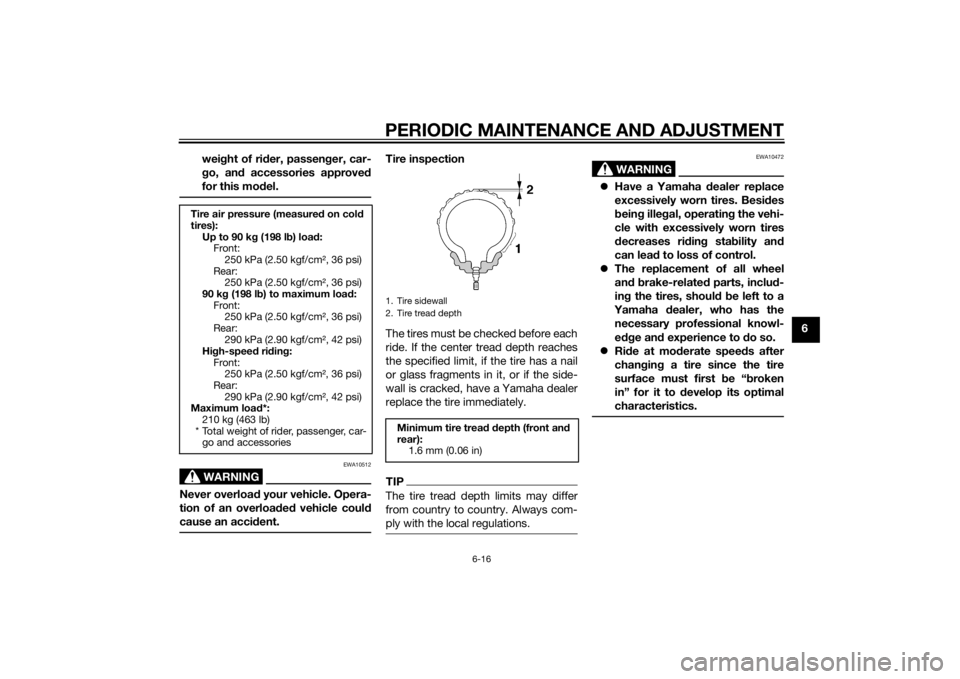
PERIODIC MAINTENANCE AND ADJUSTMENT
6-16
6
wei
ght of ri der, passen ger, car-
g o, an d accessories approve d
for this mo del.
WARNING
EWA10512
Never overload your vehicle. Opera-
tion of an overloa ded vehicle coul d
cause an acci dent.
Tire inspection
The tires must be checked before each
ride. If the center tread depth reaches
the specified limit, if the tire has a nail
or glass fragments in it, or if the side-
wall is cracked, have a Yamaha dealer
replace the tire immediately.TIPThe tire tread depth limits may differ
from country to country. Always com-
ply with the local regulations.
WARNING
EWA10472
Have a Yamaha dealer replace
excessively worn tires. Besi des
b ein g ille gal, operatin g the vehi-
cle with excessively worn tires
d ecreases ri din g sta bility an d
can lead to loss of control.
The replacement of all wheel
and b rake-relate d parts, inclu d-
in g the tires, shoul d b e left to a
Yamaha dealer, who has the
necessary professional knowl-
e dg e an d experience to d o so.
Ride at mo derate spee ds after
chan gin g a tire since the tire
surface must first b e “broken
in” for it to d evelop its optimal
characteristics.
Tire air pressure (measure d on col d
tires): Up to 90 k g (198 l b) loa d:
Front:
250 kPa (2.50 kgf/cm², 36 psi)
Rear: 250 kPa (2.50 kgf/cm², 36 psi)
90 k g (198 l b) to maximum load :
Front: 250 kPa (2.50 kgf/cm², 36 psi)
Rear: 290 kPa (2.90 kgf/cm², 42 psi)
Hi gh-spee d ri din g:
Front: 250 kPa (2.50 kgf/cm², 36 psi)
Rear:
290 kPa (2.90 kgf/cm², 42 psi)
Maximum loa d*:
210 kg (463 lb)
* Total weight of rider, passenger, car- go and accessories
1. Tire sidewall
2. Tire tread depth
Minimum tire trea d d epth (front an d
rear): 1.6 mm (0.06 in)
U2PNE0E0.book Page 16 Tuesda y, September 16, 2014 4:15 PM
Page 62 of 98
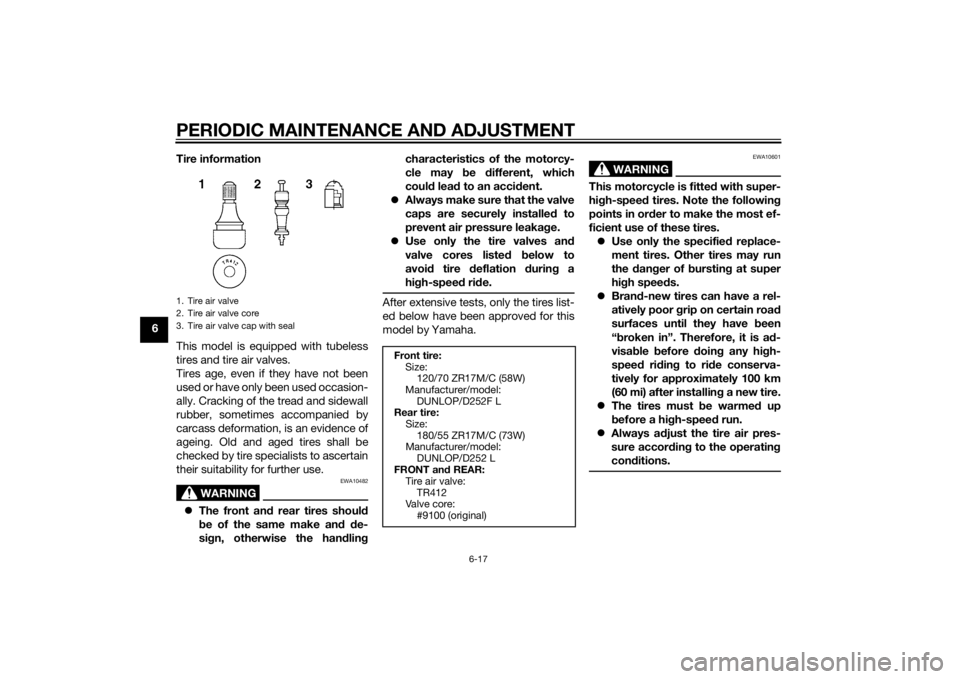
PERIODIC MAINTENANCE AND ADJUSTMENT
6-17
6Tire information
This model is equipped with tubeless
tires and tire air valves.
Tires age, even if they have not been
used or have only been used occasion-
ally. Cracking of the tread and sidewall
rubber, sometimes accompanied by
carcass deformation, is an evidence of
ageing. Old and aged tires shall be
checked by tire specialists to ascertain
their suitability for further use.
WARNING
EWA10482
The front an d rear tires shoul d
b e of the same make an d d e-
si gn, otherwise the han dlin g characteristics of the motorcy-
cle may
be different, which
coul d lea d to an acci dent.
Always make sure that the valve
caps are securely installed to
prevent air pressure leakag e.
Use only the tire valves an d
valve cores listed below to
avoi d tire deflation durin g a
hi gh-spee d ri de.
After extensive tests, only the tires list-
ed below have been approved for this
model by Yamaha.
WARNING
EWA10601
This motorcycle is fitte d with super-
hi gh-spee d tires. Note the followin g
points in or der to make the most ef-
ficient use of these tires. Use only the specified replace-
ment tires. Other tires may run
the dan ger of burstin g at super
hi gh spee ds.
Bran d-new tires can have a rel-
atively poor grip on certain roa d
surfaces until they have been
“ b roken in”. Therefore, it is a d-
visa ble before doin g any hi gh-
speed ridin g to ri de conserva-
tively for approximately 100 km
(60 mi) after installin g a new tire.
The tires must be warme d up
b efore a hi gh-spee d run.
Always a djust the tire air pres-
sure accor din g to the operatin g
con ditions.
1. Tire air valve
2. Tire air valve core
3. Tire air valve cap with seal
Front tire:
Size:120/70 ZR17M/C (58W)
Manufacturer/model: DUNLOP/D252F L
Rear tire:
Size:180/55 ZR17M/C (73W)
Manufacturer/model:
DUNLOP/D252 L
FRONT and REAR:
Tire air valve:
TR412
Valve core: #9100 (original)
U2PNE0E0.book Page 17 Tuesda y, September 16, 2014 4:15 PM
Page 63 of 98
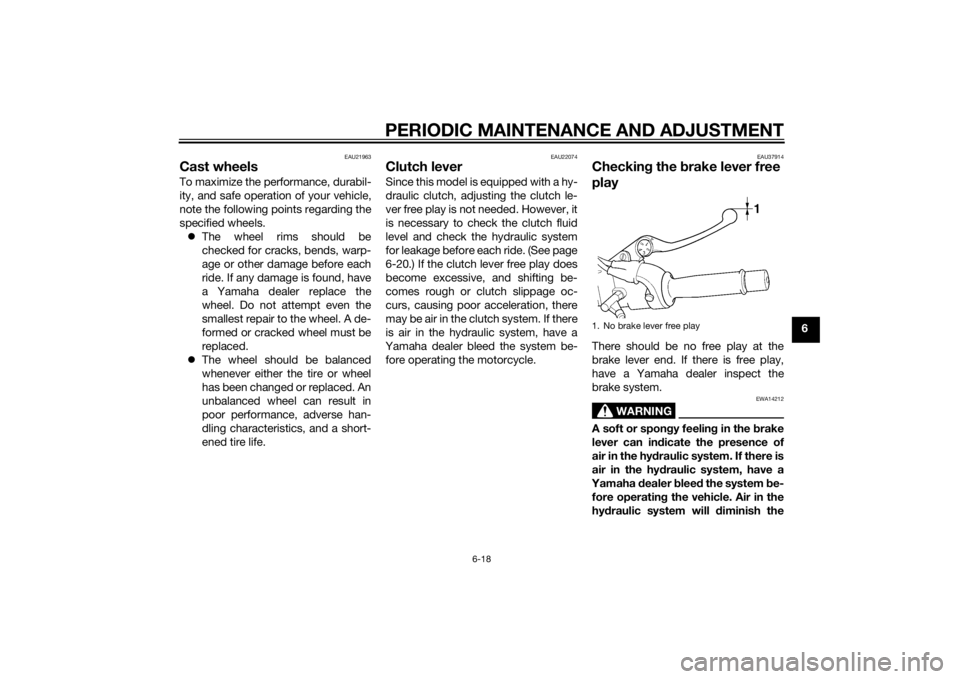
PERIODIC MAINTENANCE AND ADJUSTMENT
6-18
6
EAU21963
Cast wheelsTo maximize the performance, durabil-
ity, and safe operation of your vehicle,
note the following points regarding the
specified wheels. The wheel rims should be
checked for cracks, bends, warp-
age or other damage before each
ride. If any damage is found, have
a Yamaha dealer replace the
wheel. Do not attempt even the
smallest repair to the wheel. A de-
formed or cracked wheel must be
replaced.
The wheel should be balanced
whenever either the tire or wheel
has been changed or replaced. An
unbalanced wheel can result in
poor performance, adverse han-
dling characteristics, and a short-
ened tire life.
EAU22074
Clutch leverSince this model is equipped with a hy-
draulic clutch, adjusting the clutch le-
ver free play is not needed. However, it
is necessary to check the clutch fluid
level and check the hydraulic system
for leakage before each ride. (See page
6-20.) If the clutch lever free play does
become excessive, and shifting be-
comes rough or clutch slippage oc-
curs, causing poor acceleration, there
may be air in the clutch system. If there
is air in the hydraulic system, have a
Yamaha dealer bleed the system be-
fore operating the motorcycle.
EAU37914
Checkin g the brake lever free
playThere should be no free play at the
brake lever end. If there is free play,
have a Yamaha dealer inspect the
brake system.
WARNING
EWA14212
A soft or spon gy feelin g in the b rake
lever can in dicate the presence of
air in the hy draulic system. If there is
air in the hy draulic system, have a
Yamaha dealer blee d the system be-
fore operatin g the vehicle. Air in the
hy draulic system will diminish the1. No brake lever free play
1
U2PNE0E0.book Page 18 Tuesda y, September 16, 2014 4:15 PM
Page 64 of 98
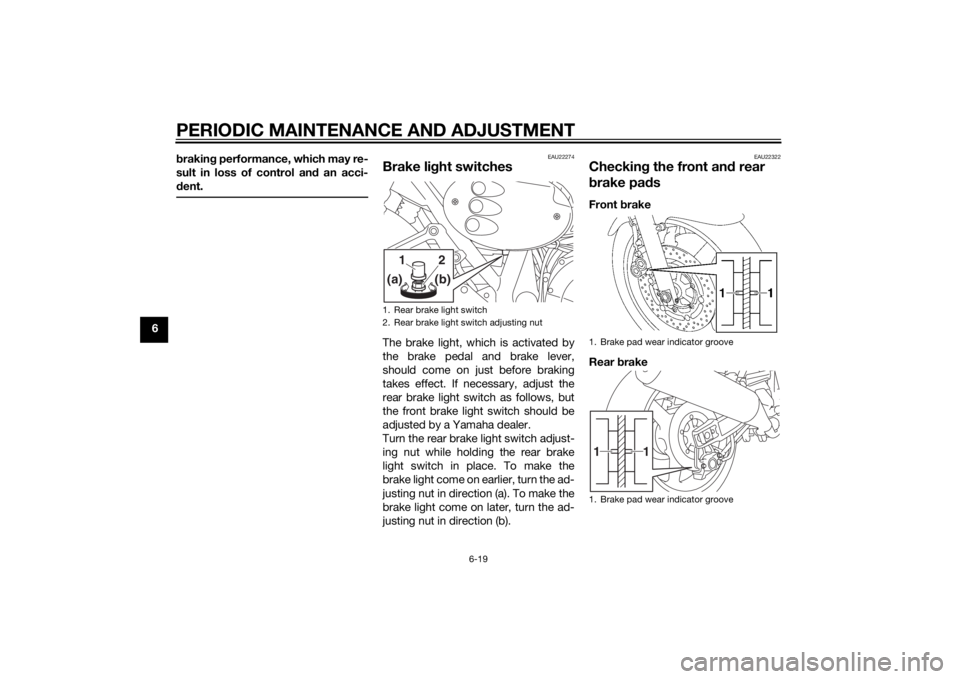
PERIODIC MAINTENANCE AND ADJUSTMENT
6-19
6b
rakin g performance, which may re-
sult in loss of control and an acci-
d ent.
EAU22274
Brake li ght switchesThe brake light, which is activated by
the brake pedal and brake lever,
should come on just before braking
takes effect. If necessary, adjust the
rear brake light switch as follows, but
the front brake light switch should be
adjusted by a Yamaha dealer.
Turn the rear brake light switch adjust-
ing nut while holding the rear brake
light switch in place. To make the
brake light come on earlier, turn the ad-
justing nut in direction (a). To make the
brake light come on later, turn the ad-
justing nut in direction (b).
EAU22322
Checkin g the front an d rear
b rake pa dsFront brake
Rear brake
1. Rear brake light switch
2. Rear brake light switch adjusting nut
1
2(b)
(a)
1. Brake pad wear indicator groove
1. Brake pad wear indicator groove1
1
U2PNE0E0.book Page 19 Tuesda y, September 16, 2014 4:15 PM
Page 65 of 98
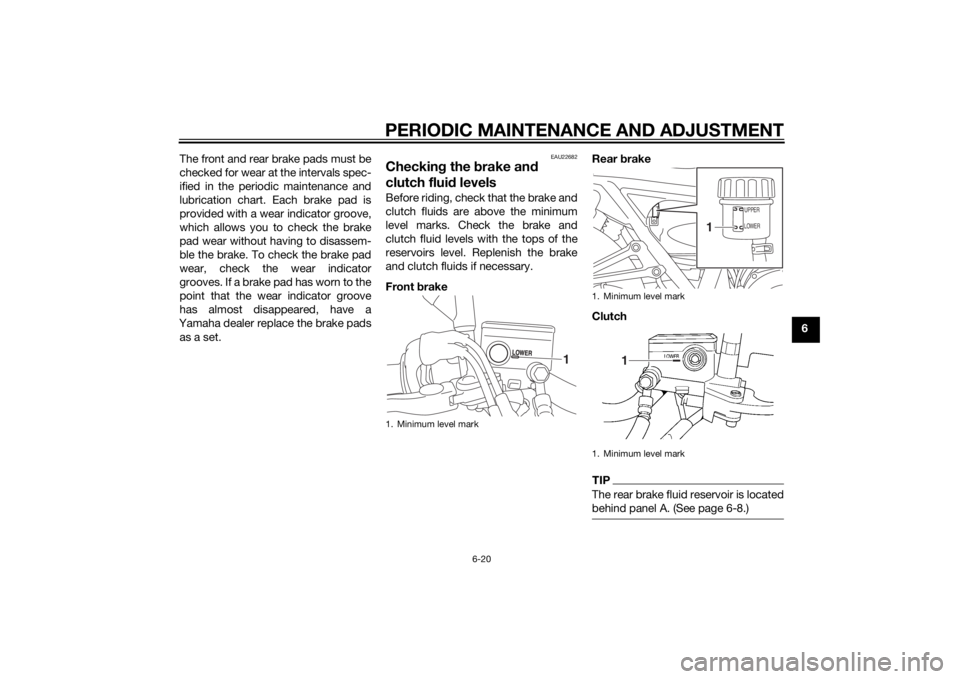
PERIODIC MAINTENANCE AND ADJUSTMENT
6-20
6
The front and rear brake pads must be
checked for wear at the intervals spec-
ified in the periodic maintenance and
lubrication chart. Each brake pad is
provided with a wear indicator groove,
which allows you to check the brake
pad wear without having to disassem-
ble the brake. To check the brake pad
wear, check the wear indicator
grooves. If a brake pad has worn to the
point that the wear indicator groove
has almost disappeared, have a
Yamaha dealer replace the brake pads as a set.
EAU22682
Checkin g the brake an d
clutch flui d levelsBefore riding, check that the brake and
clutch fluids are above the minimum
level marks. Check the brake and
clutch fluid levels with the tops of the
reservoirs level. Replenish the brake
and clutch fluids if necessary.
Front brake Rear
brake
Clutch
TIPThe rear brake fluid reservoir is located
behind panel A. (See page 6-8.)
1. Minimum level mark
1
1. Minimum level mark
1. Minimum level mark
UPPER
LOWER
1
1
U2PNE0E0.book Page 20 Tuesda y, September 16, 2014 4:15 PM
Page 66 of 98
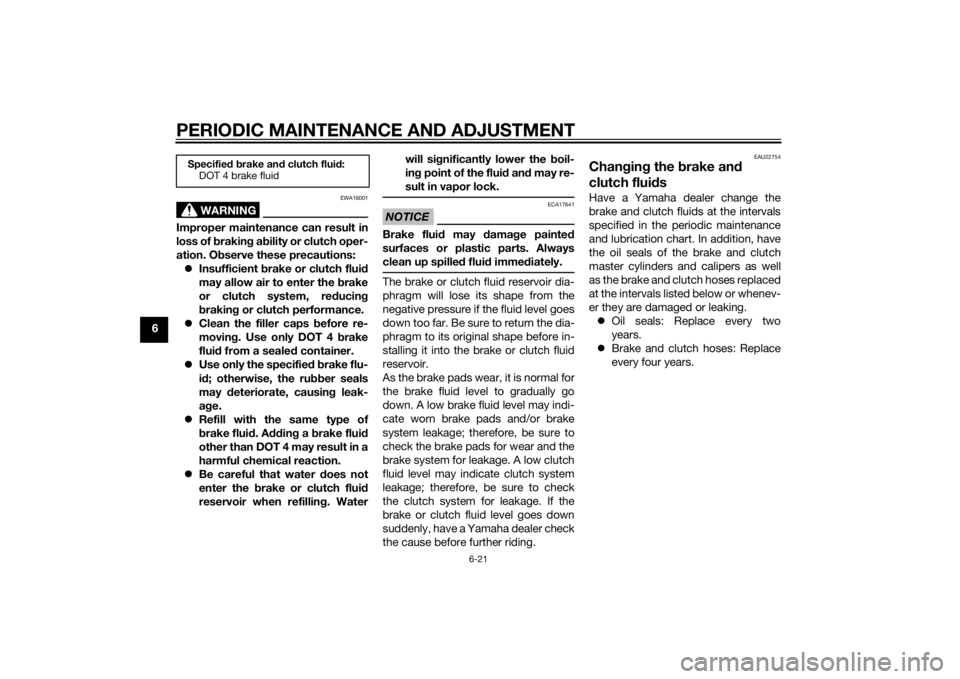
PERIODIC MAINTENANCE AND ADJUSTMENT
6-21
6
WARNING
EWA16001
Improper maintenance can result in
loss of braking a bility or clutch oper-
ation. O bserve these precautions:
Insufficient brake or clutch flui d
may allow air to enter the brake
or clutch system, re ducing
b rakin g or clutch performance.
Clean the filler caps before re-
moving . Use only DOT 4 b rake
flui d from a seale d container.
Use only the specified b rake flu-
i d ; otherwise, the ru bber seals
may deteriorate, causin g leak-
a g e.
Refill with the same type of
brake flui d. A ddin g a brake flui d
other than DOT 4 may result in a
harmful chemical reaction.
Be careful that water does not
enter the brake or clutch flui d
reservoir when refillin g. Water will si
gnificantly lower the boil-
in g point of the flui d an d may re-
sult in vapor lock.
NOTICE
ECA17641
Brake fluid may damag e painted
surfaces or plastic parts. Always
clean up spille d flui d imme diately.The brake or clutch fluid reservoir dia-
phragm will lose its shape from the
negative pressure if the fluid level goes
down too far. Be sure to return the dia-
phragm to its original shape before in-
stalling it into the brake or clutch fluid
reservoir.
As the brake pads wear, it is normal for
the brake fluid level to gradually go
down. A low brake fluid level may indi-
cate worn brake pads and/or brake
system leakage; therefore, be sure to
check the brake pads for wear and the
brake system for leakage. A low clutch
fluid level may indicate clutch system
leakage; therefore, be sure to check
the clutch system for leakage. If the
brake or clutch fluid level goes down
suddenly, have a Yamaha dealer check
the cause before further riding.
EAU22754
Chan gin g the brake an d
clutch flui dsHave a Yamaha dealer change the
brake and clutch fluids at the intervals
specified in the periodic maintenance
and lubrication chart. In addition, have
the oil seals of the brake and clutch
master cylinders and calipers as well
as the brake and clutch hoses replaced
at the intervals listed below or whenev-
er they are damaged or leaking.
Oil seals: Replace every two
years.
Brake and clutch hoses: Replace
every four years.
Specifie d b rake an d clutch flui d:
DOT 4 brake fluid
U2PNE0E0.book Page 21 Tuesda y, September 16, 2014 4:15 PM
Page 67 of 98
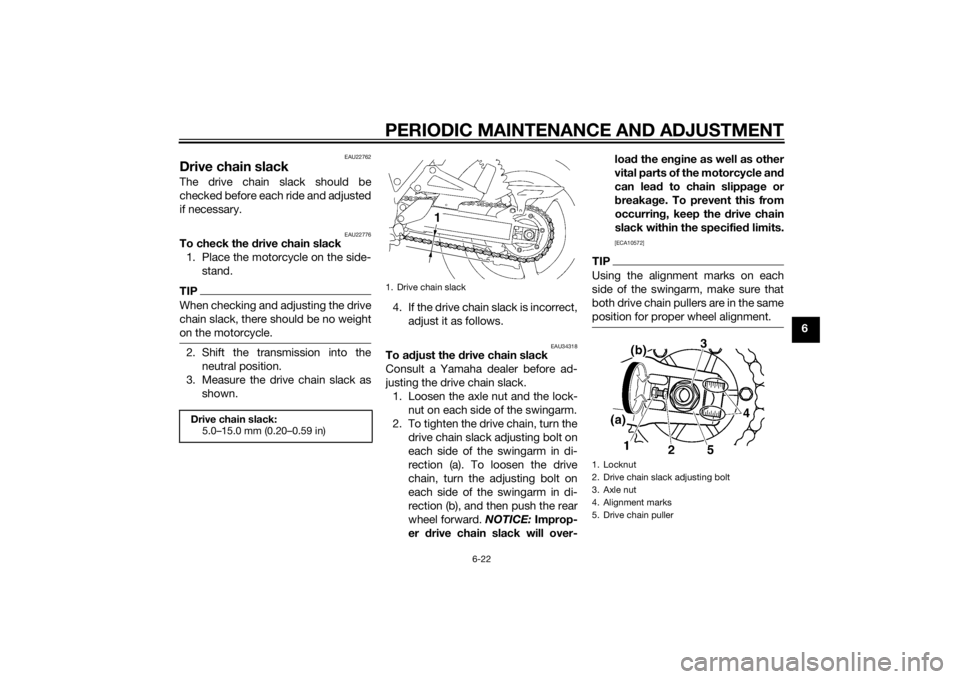
PERIODIC MAINTENANCE AND ADJUSTMENT
6-22
6
EAU22762
Drive chain slackThe drive chain slack should be
checked before each ride and adjusted
if necessary.
EAU22776
To check the drive chain slack
1. Place the motorcycle on the side- stand.TIPWhen checking and adjusting the drive
chain slack, there should be no weight
on the motorcycle.2. Shift the transmission into the neutral position.
3. Measure the drive chain slack as shown. 4. If the drive chain slack is incorrect,
adjust it as follows.
EAU34318
To a djust the drive chain slack
Consult a Yamaha dealer before ad-
justing the drive chain slack. 1. Loosen the axle nut and the lock- nut on each side of the swingarm.
2. To tighten the drive chain, turn the drive chain slack adjusting bolt on
each side of the swingarm in di-
rection (a). To loosen the drive
chain, turn the adjusting bolt on
each side of the swingarm in di-
rection (b), and then push the rear
wheel forward. NOTICE: Improp-
er drive chain slack will over- loa
d the en gine as well as other
vital parts of the motorcycle and
can lead to chain slippa ge or
b reakag e. To prevent this from
occurrin g, keep the d rive chain
slack within the specified limits.
[ECA10572]
TIPUsing the alignment marks on each
side of the swingarm, make sure that
both drive chain pullers are in the same
position for proper wheel alignment.
Drive chain slack:
5.0–15.0 mm (0.20–0.59 in)
1. Drive chain slack
1
1. Locknut
2. Drive chain slack adjusting bolt
3. Axle nut
4. Alignment marks
5. Drive chain puller
U2PNE0E0.book Page 22 Tuesda y, September 16, 2014 4:15 PM
Page 68 of 98
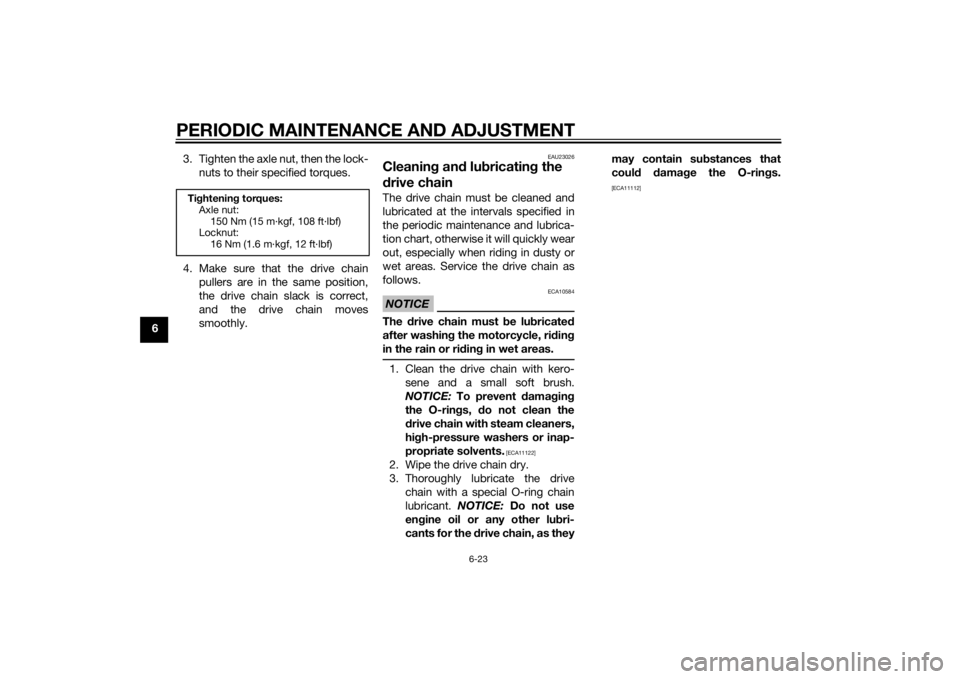
PERIODIC MAINTENANCE AND ADJUSTMENT
6-23
63. Tighten the axle nut, then the lock-
nuts to their specified torques.
4. Make sure that the drive chain pullers are in the same position,
the drive chain slack is correct,
and the drive chain moves
smoothly.
EAU23026
Cleanin g an d lu bricatin g the
d rive chainThe drive chain must be cleaned and
lubricated at the intervals specified in
the periodic maintenance and lubrica-
tion chart, otherwise it will quickly wear
out, especially when riding in dusty or
wet areas. Service the drive chain as
follows.NOTICE
ECA10584
The drive chain must b e lubricated
after washin g the motorcycle, ri din g
in the rain or ri din g in wet areas.1. Clean the drive chain with kero-
sene and a small soft brush.
NOTICE: To prevent d amaging
the O-rin gs, do not clean the
d rive chain with steam cleaners,
hi gh-pressure washers or inap-
propriate solvents.
[ECA11122]
2. Wipe the drive chain dry.
3. Thoroughly lubricate the drive chain with a special O-ring chain
lubricant. NOTICE: Do not use
en gine oil or any other lu bri-
cants for the drive chain, as they may contain su
bstances that
coul d damag e the O-rin gs.
[ECA11112]
Ti ghtenin g torques:
Axle nut: 150 Nm (15 m·kgf, 108 ft·lbf)
Locknut:
16 Nm (1.6 m·kgf, 12 ft·lbf)
U2PNE0E0.book Page 23 Tuesda y, September 16, 2014 4:15 PM
Page 69 of 98
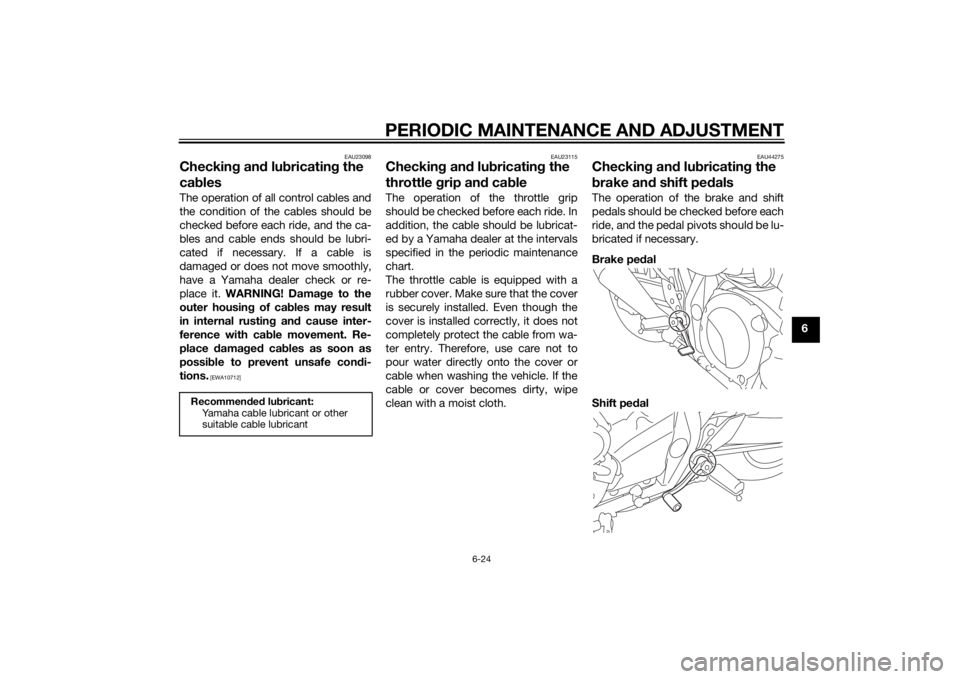
PERIODIC MAINTENANCE AND ADJUSTMENT
6-24
6
EAU23098
Checking an d lu bricatin g the
ca blesThe operation of all control cables and
the condition of the cables should be
checked before each ride, and the ca-
bles and cable ends should be lubri-
cated if necessary. If a cable is
damaged or does not move smoothly,
have a Yamaha dealer check or re-
place it. WARNING! Dama ge to the
outer housin g of cab les may result
in internal rustin g an d cause inter-
ference with ca ble movement. Re-
place damag ed cab les as soon as
possi ble to prevent unsafe con di-
tions.
[EWA10712] EAU23115
Checkin
g an d lu bricatin g the
throttle grip an d ca bleThe operation of the throttle grip
should be checked before each ride. In
addition, the cable should be lubricat-
ed by a Yamaha dealer at the intervals
specified in the periodic maintenance
chart.
The throttle cable is equipped with a
rubber cover. Make sure that the cover
is securely installed. Even though the
cover is installed correctly, it does not
completely protect the cable from wa-
ter entry. Therefore, use care not to
pour water directly onto the cover or
cable when washing the vehicle. If the
cable or cover becomes dirty, wipe
clean with a moist cloth.
EAU44275
Checkin g an d lu bricatin g the
b rake an d shift pe dalsThe operation of the brake and shift
pedals should be checked before each
ride, and the pedal pivots should be lu-
bricated if necessary.
Brake pe dal
Shift pe dal
Recommen ded lu bricant:
Yamaha cable lubricant or other
suitable cable lubricant
U2PNE0E0.book Page 24 Tuesda y, September 16, 2014 4:15 PM
Page 70 of 98
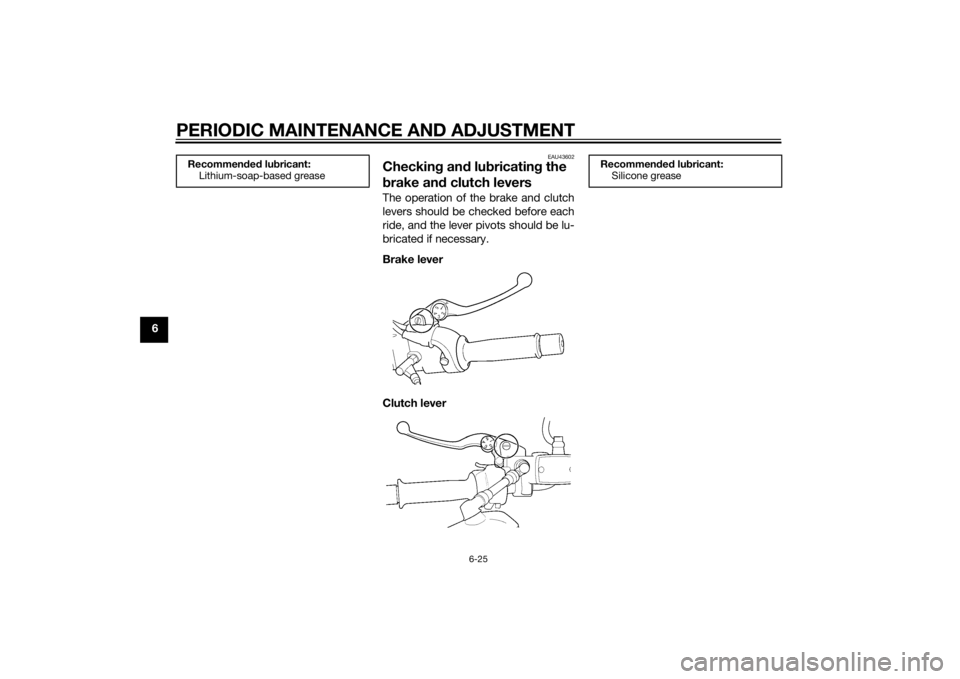
PERIODIC MAINTENANCE AND ADJUSTMENT
6-25
6
EAU43602
Checking an d lu bricatin g the
b rake an d clutch leversThe operation of the brake and clutch
levers should be checked before each
ride, and the lever pivots should be lu-
bricated if necessary.
Brake lever
Clutch lever
Recommen ded lu bricant:
Lithium-soap-based grease
Recommen ded lu bricant:
Silicone grease
U2PNE0E0.book Page 25 Tuesda y, September 16, 2014 4:15 PM